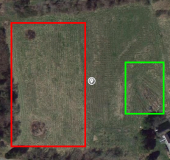I space rows to match my cultivating equipment and the crop... I weed many row crops with a lawn mover, so 36" rows for those. 30" spacing works well when I am primarily using an older Troy-bilt tiller for cultivation. I plant squash rows 8 feet apart, which makes it easy to run the tractor/tiller between rows.
I plant rows of peas about 12" apart. That allows me to run a wheel hoe between the rows. I don't much like planting in beds, because they require hand weeding. A wheel hoe really helps with cultivation first thing in the spring while weeds are small and the ground is mellow. The photo is old. I have come to prefer using only a single wheel.
I plant tomatoes on a grid: 3 feet by 6 feet. That allows me to weed by running the tiller in perpendicular directions.
Another thing that really helps with weeding is to use customized hoes and plant to match the hoes... For example this is my favorite general purpose hoe being used to weed beans, which were planted at the perfect distance for this hoe.
Another thing that I am getting better and better at doing is selecting for plant families that thrive in spite of competition from weeds.
Here's an example of a crop of garlic which was grown in weeds taller than the farmer. The garlic grew for months, in cold weather, before the warm weather weed germinated.







